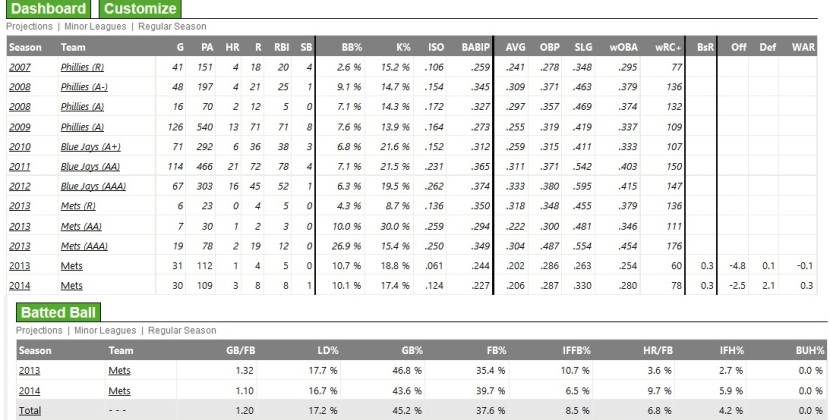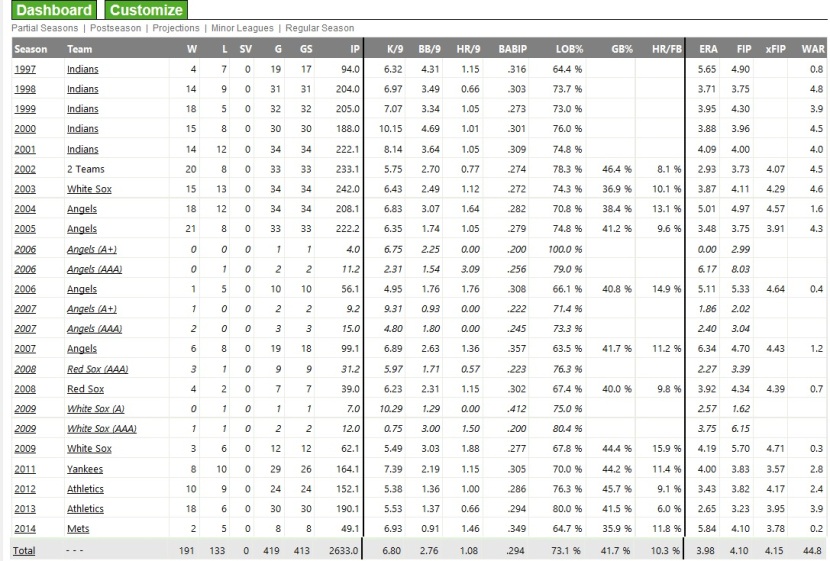Looking Up: Some Mets’ Struggles May Be Unsustainable
Early on this season — and on May 13th, it is still early on — the Mets have been nothing if not inconsistent. A 15-11 start, followed by a 1-8 stretch, and as of this writing, two straight wins. We’ve seen hot streaks (Juan Lagares until his hamstring injury, Dillon Gee, Curtis Granderson since May 1, etc.) and cold streaks (Travis d’Arnaud, Ruben Tejada and Bartolo Colon, among others). What should give Mets fans some cause for optimism…you remember what that is, right?…is that some of those cold streaks, even the ones that have lasted through the entirety of the first 37 games, are not particularly likely to continue.
Now, I could likely just as easily point out the successes that are unlikely to continue, but for the sake of optimism — and on May 13, we’re still in the domain of optimism — let’s look at why some of the struggling Mets are likely (or at least capable) of improving over the rest of the season.
Zack Wheeler
It might seem silly to start with Wheeker, after all he’s been pretty darn good as it is. He’s put up an ERA below 4.00 (thanks to a scoring change that took place Tuesday afternoon), he’s got a strong strikeout rate and has kept the Mets in games. But truth be told, Wheeler could be pitching even better. Here’s his stats via Fangraphs:
Now, many of those numbers look about right. But what if we look at the things that can be improved upon? First, his walk rate. He’s basically had no better control than his rookie season. Typically, you can expect pitchers, the more experience they gain, to walk fewer batters. That’s not universal, but he could certainly improve just a bit, perhaps drop that BB/9 figure to about 3.5. Next, his batting average on balls in play (BABIP). The major league average is .295 so far this year. Wheeler’s figure is way higher. Part of that is likely pitching in the expanse of Citi Field’s outfield, but probably not all of it. With the Mets’ outfield defense, Wheeler should be able to turn more batted balls into outs.
If Wheeler can walk fewer batters and give up fewer hits, it stands to reason all of the other statistics will begin to look better. Not the least of which are wins and losses (which, for a pitcher are not important, but the more wins Wheeler gets, the more wins the Mets get, and that’s a good thing).
Scott Rice
Rice was far from a world-beater last year, and if we’re being fair, it’s tough to expect too much more from a pitcher who never broke into the majors until his age 31 season. But looking at Rice’s numbers, it’s hard to argue that he shouldn’t pitch better than he has thus far. His statistics via Fangraphs:
Rice has been pretty poor when it comes to three major statistics: walk rate, strikeout rate and BABIP. Striking out just 6.5 batters per nine innings is not just below his figure from last year, it’s thoroughly mediocre. The same goes for walking 5.6 batters per nine innings. A sample size of just under 10 innings makes looking at relievers a bit of a farce in May, but it’s hard to imagine that Rice can’t improve both his strikeout and walk rates.
Add in a BABIP similar to Wheeler’s, and you can easily imagine a scenario in which Rice allows fewer runners and strikes out more batters. That’d allow him to strand more inherited runners and and give up fewer of his own. A pretty good combination, if he can manage it.
Ruben Tejada
This one will be unpopular. Let’s get the simplest stuff out of the way. Tejada has been mediocre for much of this year. And until the last two games, that would have been generous. I’ve been a defender of Tejada’s since Spring Training. At that point, I looked at his situation pretty simply: He put together 877 terrific plate appearances in 2011 and 2012. He hit over .280, played decent defense, and was about what you wanted as a number eight hitter…all while playing in the majors before the age of 24. Last year was terrible. He didn’t hit well, he didn’t field well and he got hurt. It was bad. But I put more stock in 877 plate appearances than I did in 227 from last year. Bigger sample size means more predictive.
The early season hasn’t quieted my fears about Tejada or anyone else’s. But looking deeper than the statistics shown during broadcasts paints a slightly different picture. Tejada has struck out more than he did in 2011 or 2012, which is a bad sign, but he’s also walking a LOT more. Add in a higher line drive percentage and a lower BABIP (that’s not a combination you often see), and one could argue Tejada has been somewhat unlucky.
Remember in 2012, when Tejada worked countless at bats to full counts, especially after falling behind 0-2? Tejada’s always had a good batting eye. If he maintains his walk rate — and even if his strikeout rate remains a bit higher than you’d like — you can expect his line drive rate and BABIP to balance out. His LD% won’t likely stay above 30%, but his BABIP should climb in the direction of major league average (which, again, is .295). I don’t know that I’m confident Ruben will hit .280 with a .330+ on-base percentage like he did in 2011-2012, but I do think he’ll see his batting average climb towards .260ish and his on-base percentage climb ever-so-slightly towards about .320. Those numbers would please any Mets fan.
Travis d’Arnaud
I’ll allow Toby Hyde of Mets Minor League Blog to start off this section:
It’s pretty simple really. He’s got above average walk and strikeout rates, which mean he’s got a good idea of where the strike zone is and he’s not swinging at too many bad pitches. He’s got a slightly below league average line drive rate, which you’d think he can improve upon. On top of all that he’s got a .230 BABIP, which is FAR below the league average. His numbers may not be there, but since an 0-15 start, he’s got a borderline respectable .244/.319/.390 slash line. Those numbers aren’t great either, but it’s a start. Look for d’Arnaud to hit even better as he gets more and more comfortable.
Bartolo Colon
He’s a 40-year-old, overweight pitcher who’s coming off a career year. So, expectations of Colon should have been tempered. He has struggled mightily — BUT — he’s only really struggled in three of his eight starts. Five of the eight have been pretty good quality.
For the sake of this exercise, let’s look at his numbers as a whole. His strikeout rate is just a hair above his career rate and his walk rate is significantly better. Much like Wheeler and Rice, Colon has been victimized by a high BABIP. Once again, that is partly because he’s playing in a big outfield where more batted balls will fall in. But it’s still a much higher number than you’d expect.
With Colon, there’s one other stat that I think lends itself to improvement between now and September: home runs allowed per fly ball. Colon was never likely to live up to his crazy rate from last year — where only six percent of fly balls allowed by Colon ended up over the fence. But to double that? That’s equally crazy. A rate of 11.8% is about average, Colon’s typically been better than average. I don’t think it’s a stretch to think that he can drop that figure a bit. If he can improve any two of those four statistics (strikeouts, walks, hits allowed and home runs allowed), you’re looking at a tolerable if excruciatingly uninteresting pitcher. The Mets would take that.
Now, all of this is an exercise in small sample sizes, best guesses and hypotheticals based on baseball (which Suzyn Waldman would have you all know, “you can’t predict”). Still, it’s far from crazy to think that these five Mets — key players all — can be noticeably better than they’ve been thus far. And if that happens, the Mets are looking a handful more wins over the rest of the season.




